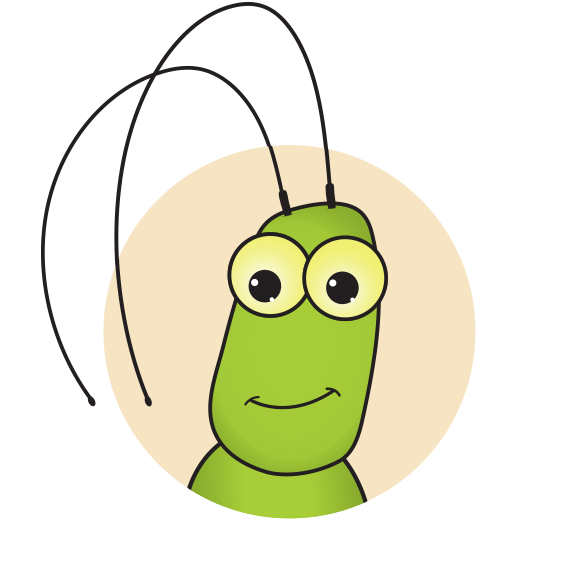Fun Facts about the Bush Katydid
Nestled in the stalks of weeds and grasses, you’ll find the source of a very peculiar sound: “cheetcheetcheet, cheetcheetcheetcheet, cheetcheetcheetcheetcheet.” This katydid is one of many species of crickets and katydids providing the nighttime symphony you hear coming from fields and road-side grasses during the summer.
These bush katydids will most likely spend their whole life in a single field or meadow. They are specially adapted for life among the foliage, with wings designed to blend in with the leaves in which they dwell. Their leaf-like wings are also the source of their sounds. By rubbing their wings together in a characteristic pattern, the males are signaling their status to the females around, in the hopes of finding a mate.
But why spend your time and energy making sounds? Katydids were driven into being active at night thousands of years ago, due to the daytime-active birds finding katydids to be quite delicious treats. As a consequence, katydids rely on sound to broadcast their presence to the other individuals in the field, hidden from each other in a shroud of darkness.
Classification:
- Order: Orthoptera
- Family: Tettigoniidae
- Subfamily: Phaneropterinae
- Genus: Scudderia
- Species: pistillata
Distinguishing features:
Green, leaf-like body and distinct, pulse-like sound
Strength:
Like most Orthopterans, katydids are great jumpers; but they are delicate creatures, fairly soft and squishy.
Speed:
Though a close relative of the katydid, the locust, is one of the fastest recorded insects (able to fly up to 200 km a day with speeds up to 21 mph!). Katydids are slower - they make short bursts of flight but prefer to walk. Because many species exhibit leaf-mimicking wings, they have not evolved an efficient ability to fly.

Photo by Ryan McGuire
Susan: Welcome to insect interviews, the show where you get to meet your favorite bugs, from your back yard to across the globe. I’m your host, Dr. Susan. Tonight we have ventured out of the studio to meet our guest, Kevin the katydid. How you doing Kevin?
Kevin: Hi Susan. I’m doing great, just finishing up dinner.
Susan: What did you have to eat?
Kevin: Well, I only eat leaves and I need to eat a lot of them to get all the energy I need to sing throughout the night.
Susan: I can’t wait to hear you sing, but first, why don’t you tell everyone a little bit about yourself?
Kevin: My name is Kevin and I’m a katydid. Sometimes I get confused for being a cricket or grasshopper. But I’m the prettiest of the bunch!
Susan: You are quite handsome. I know why katydids often get confused for crickets or grasshoppers. It’s because you all belong to the same group! Grasshoppers, crickets, and katydids all belong to the order “Orthoptera” due to you all having having long back legs that are great for jumping.
Kevin: You can tell I’m a katydid because I have long antennae, which grasshoppers don’t have, I’m slimmer and prettier than those crickets too. What do you think of these cool looking wings?
Susan: It’s amazing how much they look like leaves!
Kevin: That’s very much on purpose. Most katydids like to blend in. Some of my relatives even have wings with brown spots and damage like you find on real leaves!
Susan: I’m sure you’d be great at hide and seek. What is the reason for your camouflage?
Kevin: We look like leaves because we taste pretty good to birds, so hiding is our best defense for survival. I make lots of noise and if I didn’t look like a leaf, I’d stand out like a sore thumb.
Susan: Oh yes, I wanted to talk about the sounds you make. It’s what you’re most famously known for.
Kevin: Yes, yes, we are all excellent singers. At night, I get together with a bunch of my buddies and we all sing together. I don’t “sing” with my mouth like you would, I use my wings. I rub them together and they make a beautiful sound. I’m really good at it.
Susan: And why do you sing?
Kevin: To attract the ladies! Which of course, I do better than my buddies. I am an excellent singer.
Susan: I’m sure you are Kevin.
Kevin: Well, It’s getting pretty dark and that means it’s time for me to start singing.
Susan: I’ll be listening! Goodbye Kevin, and thank you for inviting me into your meadow.
Kevin: Bye Dr. Susan!
- Crickets and Katydids: Concerts and Solo by Vincent Dethier
- Cricket Radio: Tuning in the Night-Singing Insects by John Himmelman
- Guide to Night-Singing Insects of the Northeast by John Himmelman
- The Songs of Insects by Lang Elliott and Wil Hershberger
- Katydids and bush-crickets: Reproductive Behavior and Evolution of the Tettigoniidae by Darryl Gwynne
- Insects: Their Natural History and Diversity by Stephen Marshall


